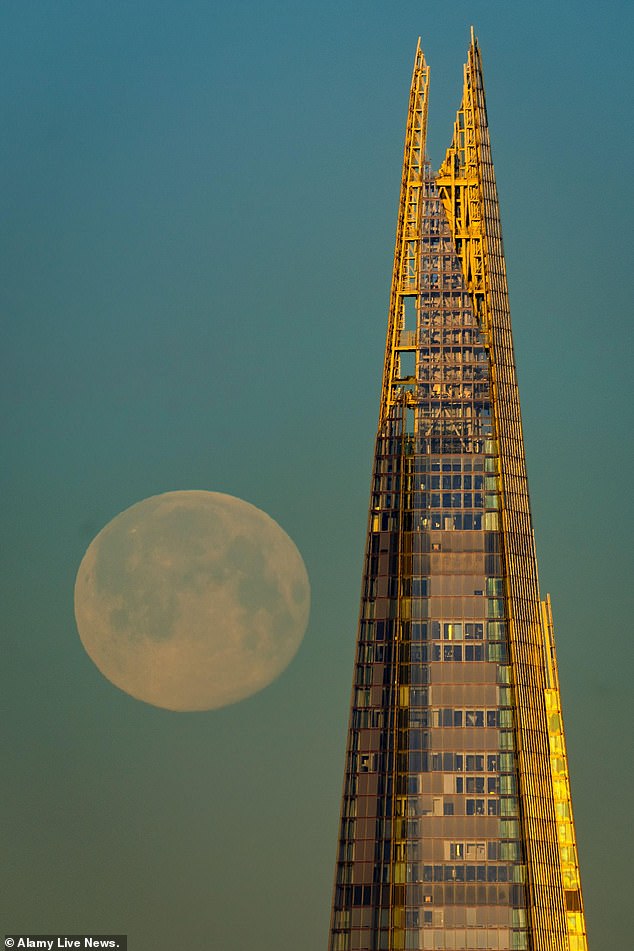The second full moon of the year will light up the night sky for the next two nights — but there is something rather unusual about this one.
Many people will have heard of supermoons – when a full moon appears brighter because it is closest to the Earth during its orbit – but February’s full moon, known as the Full Snow Moon, is actually what is called a ‘micromoon’.
This is because our lunar satellite is at its farthest point from us in its orbit and currently 251,705 miles (405,000 km) away.
It means this year’s Full Snow Moon will appear up to 14 per cent smaller than a supermoon, although most observers won’t be able to tell this difference with the unaided eye.
The spectacle reached peak illumination at around 13:29 ET (18:29 GMT) yesterday (Sunday), but it will still appear full all the way through until early Tuesday morning, according to NASA.

The second full moon of the year will light up the night sky for the next two nights — but there is something rather unusual about this one. Pictured is the Full Snow Moon over Glastonbury

Many people will have heard of supermoons – when a full moon appears brighter because it is closest to the Earth during its orbit – but February’s full moon, known as the Full Snow Moon, is actually what is called a ‘micromoon’. It is pictured above The Shard in London
A full moon occurs once every 29.5 days — the length of time it takes for it to go through a whole lunar cycle — and February’s is known as the ‘Snow Moon’ because it often coincides with heavy snowfall.
Astronomers say that to see as many of the surface details of the moon as possible, skywatchers need to give their eyes time to adjust to lower lights and turn off artificial lights sources.
The only way views might be hampered is by cloud cover, which will blanket most of Scotland and parts of northern England from 18:00 GMT.
Dr Greg Brown at Royal Observatory Greenwich told MailOnline: ‘Seeing the moon yourself shouldn’t be too difficult, as long as clouds aren’t in the way.
‘It will be easily the brightest object in the night sky and fully visible to the unaided eye; however, a pair of binoculars or a small telescope will enable you to see some of the smaller features on its surface.’
The Full Snow Moon won’t be the only other-worldly body illuminating the starry skies tonight.
Jupiter will also be bright and well-positioned for viewing for most of the night, as will Mars.
For centuries, full moon names have been used to track the seasons and therefore are closely related to nature.
February’s was also traditionally known as the Hunger Moon because of the challenging hunting conditions at this time of year.
Although 100 per cent illumination of the moon for this month occurred yesterday, our natural satellite will appear just as full tonight until Tuesday, when it will be at 99 per cent illumination.
These differences are fractional enough to be imperceptible to the naked eye, so stargazers will effectively have two more chances to see the phase of the moon in which its whole disc is illuminated.
Although it will provide a dazzling sight, tonight’s Full Snow Moon obviously won’t be as bright as last year because it is a micromoon.
And it certainly won’t come close to 2019 and 2020, when the Full Snow Moon was a ‘supermoon’.
This occurs when the full moon nearly coincides with perigee — the point in the orbit of the moon at which it is nearest to the Earth.

Lighting up the sky: This image was taken above the Thames, near Gravesend, on Sunday night

Although 100 per cent illumination of the moon for this month occurred yesterday, our natural satellite will appear just as full tonight until Tuesday, when it will be at 99 per cent illumination

A full moon occurs once every 29.5 days — the length of time it takes for it to go through a whole lunar cycle — and February’s is known as the ‘Snow Moon’ because it often coincides with heavy snowfall

Enormous: Although it will provide a dazzling sight, tonight’s Full Snow Moon won’t be as bright as the ones in 2019 (pictured in New York) and 2020, because these were supermoons
This means a supermoon can appear as much as 14 per cent larger and 30 per cent brighter than normal when viewed from Earth, depending on the time of year.
‘So long as there’s not too much cloud, the full Moon will be an unmistakable white orb in the sky,’ according to the Royal Observatory, Greenwich.
‘This is a good opportunity to use a small telescope or a pair of binoculars to see the moon’s detailed surface, or even try taking a few interesting moon photos.’
The observatory said a supermoon will arrive twice in 2023 — on August 1 and again on August 31.











